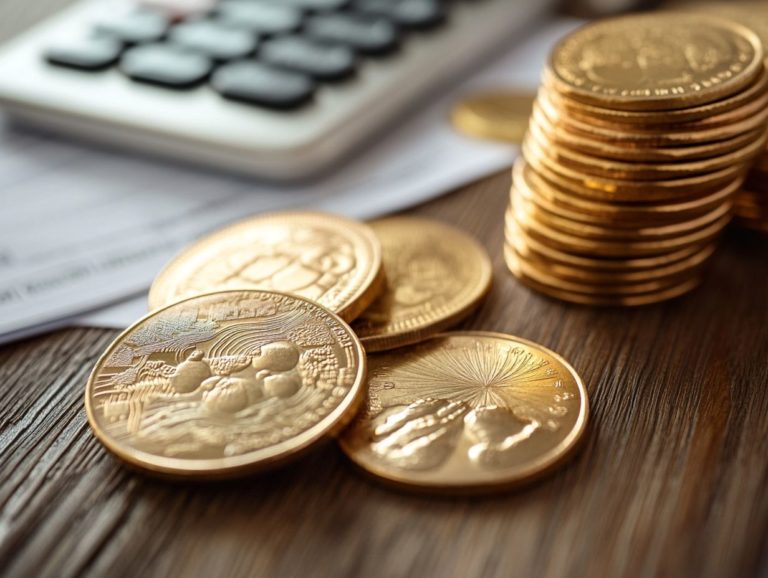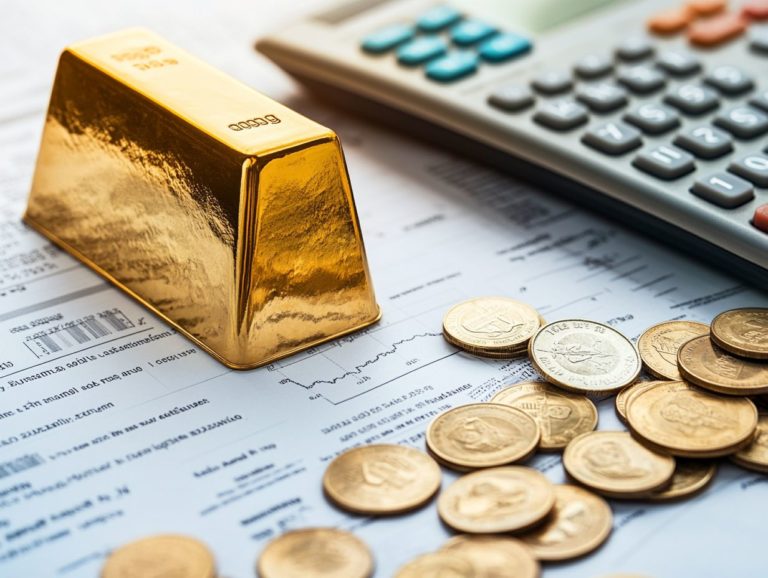How to Plan for Taxes When Investing in Precious Metals
Investing in precious metals can be highly rewarding. However, it’s essential to navigate the accompanying tax implications with care.
Understanding the various types of precious metals is essential for effective investing. Their intrinsic value plays a crucial role, especially in uncertain economic times.
This guide delves into critical tax considerations, including capital gains tax and strategies to minimize your tax burden. It also addresses necessary documentation for reporting your investments and the benefits of collaborating with a tax professional.
Whether you’re an experienced investor or just starting your journey, get ready to take charge! This guide gives you the knowledge to make informed decisions and boost your returns.
Contents
- Key Takeaways:
- Tax Considerations for Precious Metal Investments
- Strategies for Minimizing Taxes
- Reporting Precious Metal Investments on Taxes
- Working with a Tax Professional
- Frequently Asked Questions
- How do taxes work when investing in precious metals?
- What are the tax implications for short-term investments in precious metals?
- What are the tax implications for long-term investments in precious metals?
- Are there any tax breaks for investing in precious metals?
- Do I need to pay taxes on my precious metals even if I don’t sell them?
- Are there any tax-free options for investing in precious metals?
Key Takeaways:
- Be aware of taxes when investing in precious metals. Taxes can greatly affect your investment returns.
- Consider the tax implications of different investment strategies. For instance, holding onto metals long-term or offsetting gains with losses.
- Seek guidance from a tax professional to ensure proper reporting and to potentially minimize taxes on your precious metal investments.
Types of Precious Metals and Their Value
Investing in these metals not only helps preserve your wealth but also plays a critical role in protecting your assets. Market values can be volatile, swayed by geopolitical tensions and economic shifts. Staying informed is vital.
Gold has long been the go-to option for those seeking stability, especially during inflationary periods. Meanwhile, silver’s industrial demand adds to its appeal as an investment. Platinum, often overshadowed by its more popular counterparts, is gaining traction as a valuable choice for diversification in your investment portfolio.
Each metal serves a distinct purpose, enabling you to create a balanced strategy that effectively hedges against the unpredictable nature of the market.
Tax Considerations for Precious Metal Investments
Investing in precious metals entails navigating a complex landscape of tax considerations that you must grasp to fully optimize your financial growth while minimizing tax liabilities. The IRS classifies precious metals such as gold and silver as collectibles, and this classification affects the tax rates you encounter compared to other asset classes.
Understanding the implications of capital gains tax—this is the tax on profit from selling assets—is essential for crafting an effective tax strategy. The distinctions between long-term and short-term gains are crucial. Your tax obligations will vary depending on the investment vehicle you choose, whether it’s physical gold, mutual funds, or ETFs.
Capital Gains Tax and Other Taxes
Capital gains tax plays a crucial role in the tax implications of your precious metal investments. Rates vary based on whether your gains are classified as long-term or short-term. When you hold precious metals for over a year, you benefit from the more favorable long-term capital gains tax rates. Conversely, if you realize short-term gains by selling assets held for a year or less, those profits are taxed at ordinary income rates, significantly increasing your tax liability.
Understanding these distinctions is essential for effective tax planning and ensuring compliance with IRS regulations. The variety of precious metals—like gold, silver, platinum, and palladium—can also shape your investment strategy. For instance, if you decide to sell gold bullion after just six months, those profits will face the heftier ordinary income tax rates, creating a substantial tax burden.
However, if you hold onto that gold for a full year before selling, you’ll likely enjoy a much more favorable long-term capital gains rate, leading to considerable tax savings. It’s vital for you to not only be aware of these timelines but also to consider holding periods when planning your purchases. Understanding these implications can profoundly influence your overall financial strategy.
Strategies for Minimizing Taxes
Employing effective strategies for minimizing taxes is essential for maximizing your investment returns in precious metals.
You can leverage various tax planning techniques, such as tax loss harvesting, to offset gains with losses and strategically lower your overall tax liability.
Understanding available tax deductions and adhering to accurate reporting guidelines can lead to considerable savings.
By integrating these strategies, you can enhance your financial growth while ensuring compliance with IRS regulations.
Long-Term vs. Short-Term Investments
The distinction between long-term and short-term investments is essential when considering the tax on profits from selling investments for precious metals. Long-term investments—held for over a year—typically enjoy lower capital gains tax rates, making them more appealing for strategic investors like you.
In contrast, short-term gains, which apply to assets held for one year or less, are taxed at ordinary income tax rates, potentially inflating your tax bill significantly.
By understanding these classifications, you can craft optimized investment strategies that align with your financial goals.
When allocating funds into gold, silver, or other precious metals, consider your time horizon carefully. Long-term strategies can alleviate tax burdens and provide a buffer against market volatility, as these assets often appreciate over time.
If you’re drawn to short-term trading, you may find opportunities in sudden price fluctuations. However, be mindful that this approach exposes you to higher taxation and increased risks.
The physical nature of these investments complicates liquidity and transaction costs, further impacting your decision-making process.
Offsetting Gains with Losses
Offsetting gains with losses, also known as tax loss harvesting, is a savvy strategy to manage your capital gains tax liability. By selling investments that have dipped in value, you can use those losses to balance out gains from profitable investments in precious metals, ultimately reducing your taxable income.
This approach not only boosts your tax efficiency but also fosters better financial growth, making it an essential part of your tax strategy.
For example, if you make a $10,000 profit from gold but lose $4,000 from silver, selling the silver helps reduce the tax you owe on the gold profits.
While this strategy has notable benefits, it’s crucial to be aware of the wash-sale rule. This rule means you can’t claim a loss for tax purposes if you buy the same investment again within 30 days.
By effectively implementing tax loss harvesting, you can achieve substantial tax savings and cultivate a more strategic financial portfolio.
Reporting Precious Metal Investments on Taxes
Accurate reporting of precious metal investments on your taxes is crucial for staying compliant with IRS guidelines and fulfilling your tax obligations.
Be aware of specific reporting requirements, such as the necessity of Form 1099-B, which outlines the proceeds from the sale of precious metals and other securities.
Meticulous record-keeping is essential to substantiate your claims and deductions, ensuring you meet your legal responsibilities while optimizing your tax position.
Neglecting these requirements could result in penalties and increased scrutiny from the IRS, so it’s best to stay ahead of the game.
Start applying these strategies today to see your investment returns grow!
Forms and Documentation Needed
To accurately report your precious metal investments, you’ll need specific forms and documentation to stay in line with IRS regulations. Among these, Form 1099-B holds particular significance; it details the proceeds from the sale of your precious metals and is essential for reporting capital gains (profit made from selling an investment for more than you paid for it). By understanding the required documentation and adhering to reporting guidelines, you can meet your reporting requirements while minimizing the risk of IRS audits. Preparing these documents is key to a hassle-free tax filing experience.
Alongside Form 1099-B, keep careful records of your purchase invoices, sales receipts, and any correspondence related to your transactions. These documents act as supportive evidence should an audit arise and help ensure the accuracy of your reported information. Organizing these records systematically will make them easily accessible when tax season rolls around.
Consider consulting a tax professional to gain valuable insights into any additional forms that might be pertinent based on your individual investment strategies. This proactive step can help enhance your compliance with federal requirements and give you peace of mind.
Working with a Tax Professional
Collaborating with a tax expert can remarkably elevate your ability to navigate the intricate world of tax planning for precious metal investments. These experts offer invaluable insights into compliance, helping you grasp your tax obligations while optimizing your financial growth through strategic investment approaches.
With their deep understanding of the latest regulations and tax laws, tax professionals can expertly guide you in maximizing tax advantages and ensuring that all reporting requirements are seamlessly met.
Benefits of Seeking Professional Advice
Seeking professional advice from a tax expert can offer you a wealth of benefits, especially if you’re an investor in precious metals aiming to optimize your tax planning. These specialists can craft personalized investment strategies that not only enhance your financial growth but also ensure you remain compliant with IRS regulations.
With their in-depth knowledge of tax laws, they can help you deftly navigate complex issues like capital gains tax, minimizing your tax liability while maximizing your returns.
By collaborating with a seasoned tax advisor, you can embrace proactive tax planning throughout the year instead of scrambling when tax season rolls around. For instance, a tax expert might suggest strategies like tax-loss harvesting (a strategy to reduce taxes by selling losing investments to offset gains), allowing you to offset gains in some investments with losses in others, effectively lowering your overall taxable income.
These experts are always on top of changing tax laws, empowering you to seize new opportunities as they come. This foresight can lead to more informed decisions regarding retirement accounts or other tax-advantaged investments, ultimately setting you on the path to long-term financial success.
Frequently Asked Questions
How do taxes work when investing in precious metals?
Taxes on precious metals investments are treated differently depending on the type of metal and the duration of the investment. Generally, gains on precious metals are subject to capital gains tax, but there are some exceptions and specific rules for different types of metals.
What are the tax implications for short-term investments in precious metals?
If you hold onto your precious metals for less than a year before selling, you will be subject to short-term capital gains tax, which is the same rate as your regular income tax. This rate can range from 10% to 37%, depending on your income bracket.
What are the tax implications for long-term investments in precious metals?
If you hold onto your precious metals for more than a year before selling, you will be subject to long-term capital gains tax, which is typically lower than short-term capital gains tax. The exact rate will depend on your income bracket, but it is generally between 0% to 20%.
Are there any tax breaks for investing in precious metals?
Yes, certain tax breaks exist for investing in precious metals. If you own gold or silver coins, you might qualify for a deduction on your federal income tax return.
Consult a tax professional to explore the best options for your situation.
Do I need to pay taxes on my precious metals even if I don’t sell them?
Yes, taxes may apply to your precious metals, even if you don’t sell them. You might have to pay annual taxes on your physical gold or silver, similar to property taxes.
Check your state’s tax laws to understand specific requirements.
Are there any tax-free options for investing in precious metals?
Yes, you can consider tax-free options like investing in a self-directed IRA. This allows you to hold physical gold, silver, and other precious metals without immediate tax consequences.
Remember, taxes will apply when you withdraw funds in the future.



















